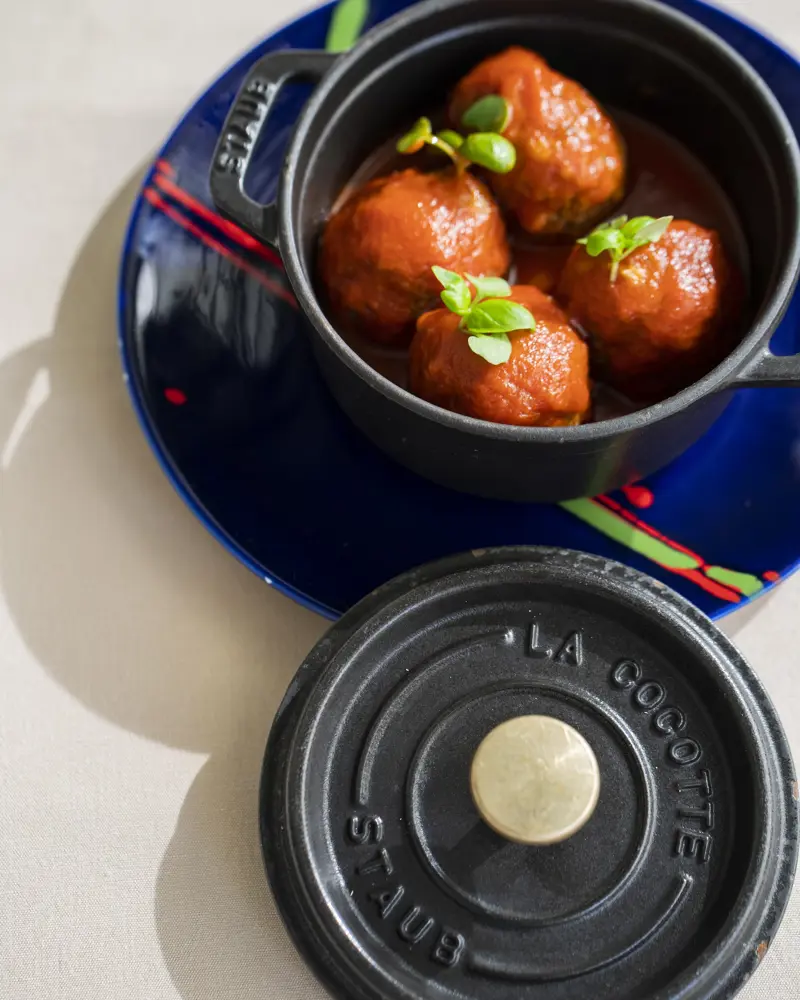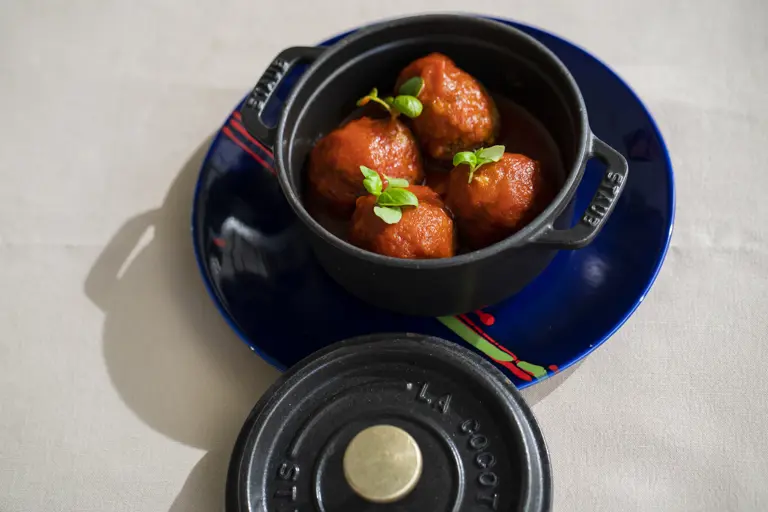RECIPE: BEEF MEATBALLS WITH TOMATO RAGÙ
08.07.2024 RECIPES
The meatballs are a cinch to make once you’ve sourced some quality minced beef from a trusted local butcher. The ragù sauce is a little more time-consuming, but a morning spent preparing good things in the kitchen is never a morning wasted. Bear in mind also that the sauce keeps well in the freezer – so you might as well make a large batch. It’s just as good on pasta as it is in casseroles like this one.
Ragù has achieved ritual status in Naples. Traditionally made on Sunday mornings for the lunch that brings the whole family together, it would see the designated cook – generally la nonna – get up at the crack of dawn to begin the long six or seven hour process that lies behind every ragù worth the name. Still today, the scent of il ragù della domenica is the scent of Sunday morning in Naples. Tasted after periods of exile (because no true Neapolitan would dream of ordering ragù in Milan, or New York), it has been known to reduce grown men to tears.
BEEF MEATBALLS WITH TOMATO RAGÙ
Serves four
For the meatballs:
300g (10.5oz) minced beef
100g (3.5oz) white breadcrumbs
50g (1.75oz) grated parmesan
1 egg yolk
a handful of parsley
salt and pepper to taste
For the ragù:
500g (17.5oz) beef offcuts (see below)
2 onions, chopped into small cubes
2 stalks celery, cut matchstick style
3 carrots, cut matchstick style
1.5 litres (1.6 quarts or 6.3 cups) tomato passata
200g (7oz) red wine
a handful of basil

First, a word on the cuts of beef that are most commonly used to make ragù napoletano sauce. These would always be ‘poorer’ cuts unsuitable for steaks and fillets. They include scaramella, a cut that takes in the intercostal muscles between back and chest, and locena, a shoulder cut that comprises a fair amount of fat, which lends flavour to the ragù. Many recipes also include morsels of pork such as pancetta, but these can easily overpower the beef notes. At Le Sirenuse, chef Gennaro Russo opts for an all-beef ragù, but carefully doses the beef cuts to bring out the flavour. Best advice is to consult a good butcher, or a Neapolitan relative if you have one, and try a few different mixes of ‘cheap’ beef cuts until you achieve ragù nirvana.
Whichever cuts you use, do not reduce the beef, cartilage and fat to mincemeat as you would with Bolognese sauce. Neapolitan ragù calls for irregular-sized chunks of meat – aim for pieces up to three inches long. These stew for hours in the sauce and are removed before serving – by which time fragments will have naturally flaked off and blended in with the sugo (if you prefer a smoother and more homogenous ragù, let the sauce cool a little when it’s ready, and strain it through a fine-meshed sieve or cloth strainer).
Begin by heating some olive oil on a lively flame in a heavy-bottomed pan or cast iron skillet. Toss in the beef chunks and turn until they’re lightly toasted all over. Take them out without discarding the oil and meat juices, and add the onion, celery and carrot to the pan, tossing to coat well. When the vegetables are lightly fried, put the meat chunks back in, add the red wine, and simmer until reduced. Once everything is amalgamated and flavorsome, pour in the tomato passata and throw in the basil (all except the sprigs you're reserving for the garnish), half cover the pan, and lower the heat until it’s just simmering. Neapolitans have a wonderfully onomatopoeic dialect word for this slow bubbling boil: they say the ragù has to pippiare. Leave to cook and reduce for five or six hours (yes, you read that right!), stirring every so often.
To make the meatballs, put the mincemeat in a large bowl, add the egg yolk and stir, then add the breadcrumbs and other ingredients, finishing with the salt and pepper. Mix in well, then leave to rest in the fridge for half an hour or so. Finally, shape into meatballs of your desired size, and arrange on greaseproof paper. In a pan, heat some light cooking oil (Gennaro uses peanut oil) to 160°C (320°F). Ideally the oil should cover the meatballs completely, but if you prefer to be sparing, you can get away with covering them halfway as long as you turn them to fry them evenly on both sides. Drop the meatballs carefully into the oil with a spoon and fry until golden – six or seven minutes should be enough.
Finally, when you’re ready to serve dinner, pour the sauce into four individual casserole mini-pans, add enough meatballs to each for a single serving, and place on a medium heat for a few minutes so that the meatballs absorb the sauce. Finally, sprinkle on the parmesan, place under a hot grill so that it melts, add some basil leaves and serve.
Photos © Roberto Salomone
Le Sirenuse Newsletter
Stay up to date
Sign up to our newsletter for regular updates on Amalfi Coast stories, events, recipes and glorious sunsets



